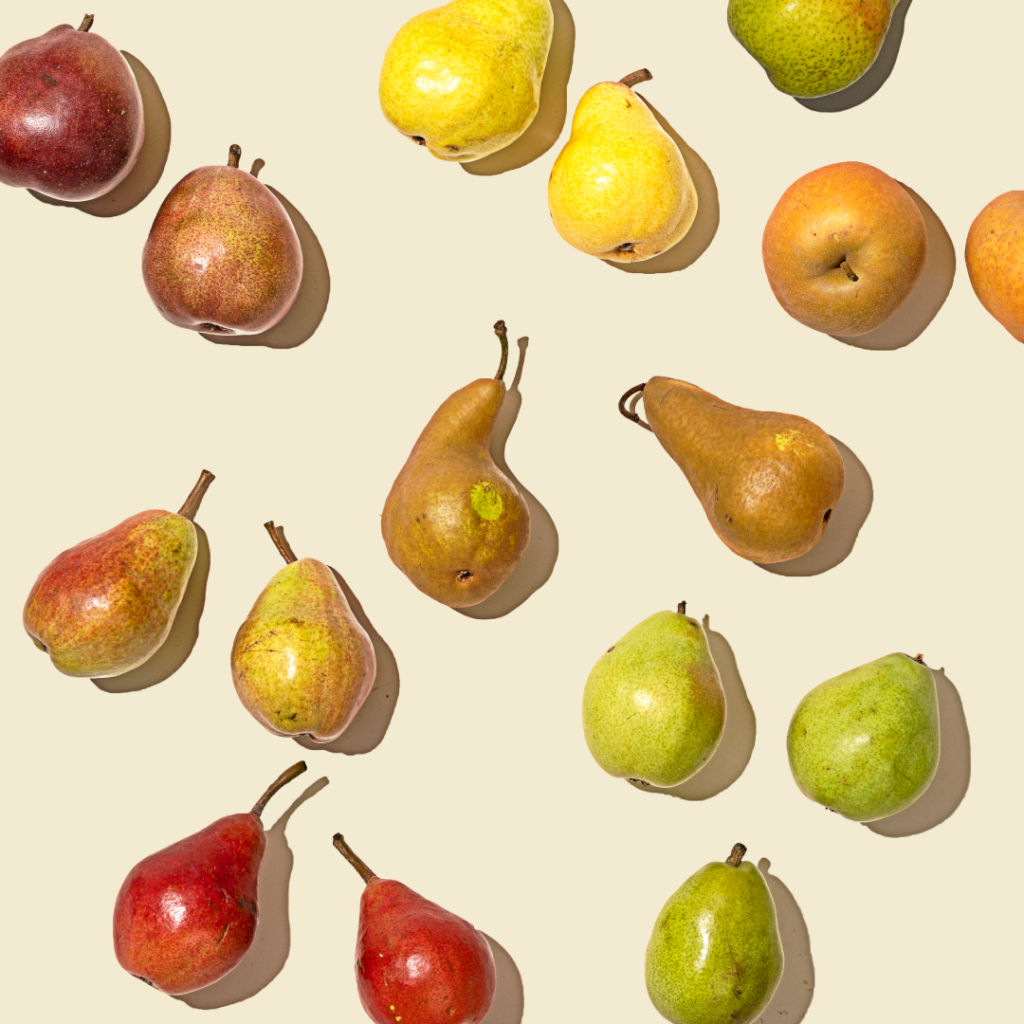
A group of orchard fruit that’s the hallmark of fall, pears are members of the rose family and are abundantly featured in autumnal dishes, scents, and spreads. Because no pear is created equally—each brings its own special blend of traits to the table—we’ve spelled out what differentiates the most common varieties so you can have it all in one place.
Sign up to get organic groceries delivered with Misfits Market!
BARTLETT PEARS
The Look: Delightfully stout, with a soft curve that creates the characteristic “pear-like” bell shape. Its smooth, subtly dappled green skin changes to a warm yellow as it ripens; sometimes, occasional patches of blushing will appear, too.
The Taste and Texture: Highly aromatic, with a flavor that’s markedly pear-like. The yellower a Bartlett pear is, the more sweet and juicy the taste and texture will be, so they’re highly customizable—greener bartletts make a great add-in to green salads if you prefer ‘em on the tarter side.
The Best Uses: Their aroma and distinct “peariness” makes Bartletts particularly popular for canning, preserving, or dehydrating.
RED BARTLETT PEARS
The Look: Shaped much like their green-yellow counterparts, but with a more narrow neck. Like yellow Bartletts, red Bartletts brighten as they ripen turning from deep crimson to a brilliant, warm red that’s sometimes streaked with yellow towards the base.
The Taste and Texture: Red Bartletts go through the same transformation of texture and taste, too—some even claiming red bartletts are sweeter and juicer at their most ripe.
The Best Uses: The same applies here. Red Bartletts are similarly versatile, can be used at multiple stages of ripeness, and have a definitive “peary” flavor that wonderfully complements savory ingredients.
GREEN D’ANJOU PEARS
The Look: Quite similar to Bartletts, but more spherical and uniform as D’Anjou pears lack the pear-like curvature. With smooth, grassy green skin, they’re a close color match, too, but unlike Bartletts, D’Anjous remain the same hue.
The Taste and Texture: Since they don’t change color, you can ID a ripe D’Anjou by giving the stem or neck a gentle press—if it’s ready, there’ll be a slight give. (Because pears ripen from the inside out, a d’anjou that’s soft at its widest point is over-ripe.) They’re a tad less juicy and sweet than bartletts, and a flavor layered with refreshing, citrus-like notes.
The Best Use: Think of D’Anjous as your all-around pear. Their dense flesh holds up well to baking or roasting—like in our default use for overripe fruit—but is just as tasty when snacked on out-of-hand.
RED D’ANJOU PEARS
The Look: Red D’Anjou pears have an identical silhouette to their green sibs (so they’re more egg-shaped compared to red bartletts). Their skin is smooth, finely speckled, and dark red. On occasion, lighter, vertical stripes appear as well.
The Taste and Texture: Like with green D’Anjou pears, a soft press at the nape of its neck is a good test of its ripeness—though they sometimes display a faint change in color. They’re also milder and aren’t citrus-noted, though their fresh, sweet flavor does have a subtle tang to it.
The Best Uses: Use ‘em as you would green D’Anjou pears—especially in instances where a dish or baked good would benefit from a pop of red.
BOSC PEARS
The Look: Fairly slender, yet still distinctively bell-shaped. Bosc pears have thin skin that’s a warm brown hue, matte in color and feel, and susceptible to scarring (if that’s the case, know that it’s only skin-deep!).
The Taste and Texture: Their flesh is soft yet structured and incredibly juicy, with a honeyed sweetness and notes that are vaguely woody. As bosc pears ripen, their color warms ever so slightly and small wrinkles may develop around the base of the stem.
The Best Uses: Since bosc pears are denser and retain their shape better than many other varieties, they’re often the default for broiling, baking, and poaching, especially in desserts such as these Baked Pears with Salted Caramel.
STARKRIMSON PEARS
The Look: As its name suggests, the starkrimson’s smooth crimson skin transforms into a warm, incredibly vibrant shade of red once ripe.
The Taste and Texture: Pleasant, smooth, and juicy flesh with a flavor that’s sweet yet mild with faint floral notes.
The Best Uses: Starkrimsons are known as summer pears since they’re some of the earliest to be harvested, usually starting in August. They’re ideal for using fresh, especially on a charcuterie board in the company of end-of-summer produce.
ASIAN PEARS
With matte, yellow-brown skin and an apple-like texture, asian pears are so unique that we wanted to give ‘em their very own highlight and share the many reasons Why You Should Be Eating More Asian Pears.
